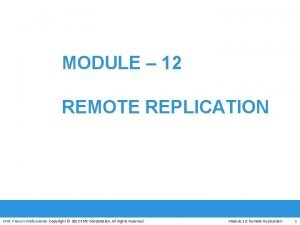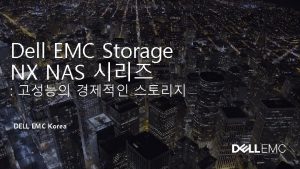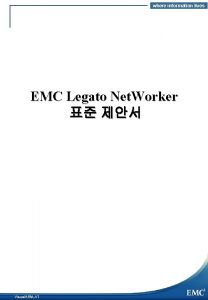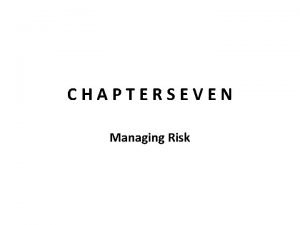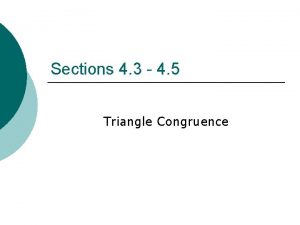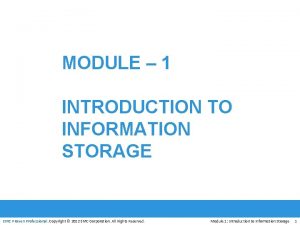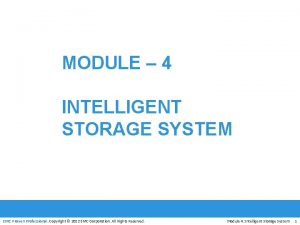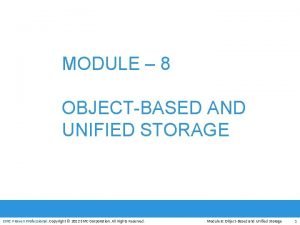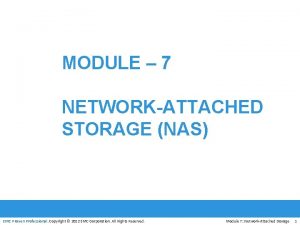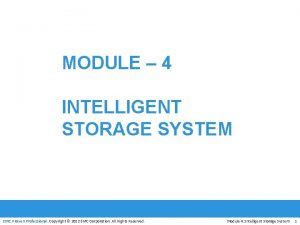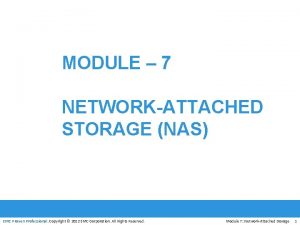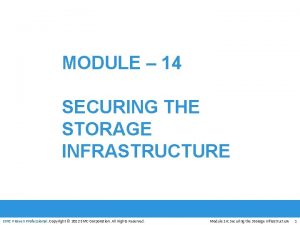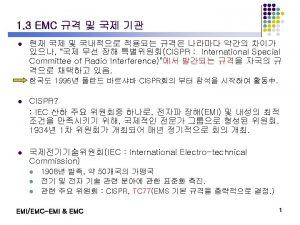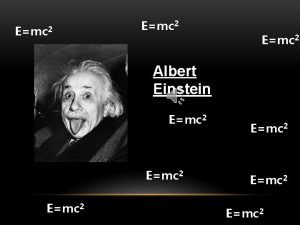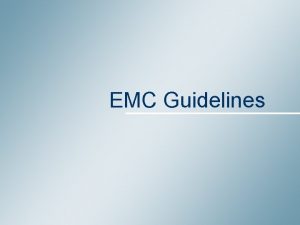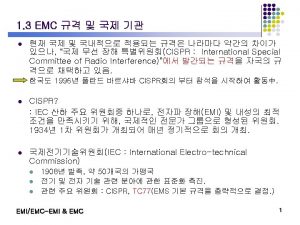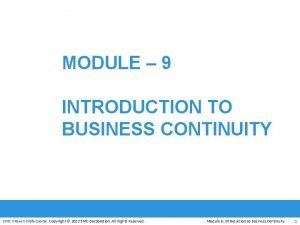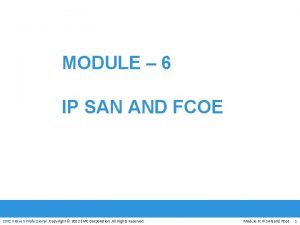MODULE 1 INTRODUCTION TO INFORMATION STORAGE EMC Proven
















- Slides: 16

MODULE – 1 INTRODUCTION TO INFORMATION STORAGE EMC Proven Professional. Copyright © 2012 EMC Corporation. All Rights Reserved. Module 1: Introduction to Information Storage 1

Module 1: Introduction to Information Storage Upon completion of this module, you should be able to: • Define data and information • Describe types of data • Describe the evolution of storage architecture • Describe the core elements of a data center • List the key characteristics of data center • Provide an overview of virtualization and cloud computing EMC Proven Professional. Copyright © 2012 EMC Corporation. All Rights Reserved. Module 1: Introduction to Information Storage 2

Why Information Storage and Management? • Information is the knowledge derived from data • Growth of digital information has resulted in information explosion • We live in an on-command, on-demand world 4 We need information when and where required 8 Internet searching, social networking, e-mails, share pictures & videos. • Increasing dependency on fast and reliable access to information 4 E. g. : airline reservations, telecommunications billing, e-commerce, e- banking, credit card processing • Businesses seek to store, protect, optimize, and leverage (use to maximum advantage) the information 4 To gain competitive advantage 4 To derive new business opportunity EMC Proven Professional. Copyright © 2012 EMC Corporation. All Rights Reserved. Module 1: Introduction to Information Storage 3

What is Data? Data It is a collection of raw facts from which conclusions may be drawn. • Data is converted into more • convenient form − digital data Digital data – accessible by the user only after a computer processes it. Digital Movie Digital Photo e-Book email Letter 10101011010 00010101011 01010101010 1010101 Digital Data EMC Proven Professional. Copyright © 2012 EMC Corporation. All Rights Reserved. Module 1: Introduction to Information Storage 4

Factors for digital data growth are: Increase in dataprocessing capabilities • Conversion from conventional forms to digital forms Lower cost of digital storage Affordable and faster communication technology • Cost of storage devices have provided low-cost storage solutions • Rate of sharing digital data is much faster than traditional approaches EMC Proven Professional. Copyright © 2012 EMC Corporation. All Rights Reserved. Proliferation (Rapid increase) of applications and smart devices • Smartphones, tablets, and newer digital devices, along smart applications, have significantly contributed to the generation of digital content Module 1: Introduction to Information Storage 5

Types of Data • Data can be classified as: 4 Structured 8 Organized in rows and columns in a defined format 8 Applications can retrieve and process it efficiently 8 Typically stored using DBMS 4 Unstructured 8 If its elements cannot be stored in rows and columns 8 E. g. : sticky notes, email messages, business card, digital format files email Attachments PDFs Unstructured (90%) X-rays Manuals Images Forms Contracts Instant Messages Documents Web Pages Rich Media Invoices Structured (10%) Database Audio, Video • Majority of data being created is unstructured EMC Proven Professional. Copyright © 2012 EMC Corporation. All Rights Reserved. Module 1: Introduction to Information Storage 6

Big Data It refers to data sets whose sizes are beyond the ability of commonly used software tools to capture, store, manage, and process within acceptable time limits. • Includes both structured and unstructured data generated by • variety of sources Big data analysis in real time requires new techniques and tools that provide: 4 High performance 4 Massively parallel processing (MPP) data platforms 4 Advanced analytics • Big data analytics provide an opportunity to translate large volumes of data into right decisions EMC Proven Professional. Copyright © 2012 EMC Corporation. All Rights Reserved. Module 1: Introduction to Information Storage 7

Storage • Stores data created by individuals and organizations 4 Provides access to data for further processing • Examples of storage devices are: 4 Media card in a cell phone or digital camera 4 DVDs, CD-ROMs 4 Disk drives 4 Disk arrays 4 Tapes EMC Proven Professional. Copyright © 2012 EMC Corporation. All Rights Reserved. Module 1: Introduction to Information Storage 8

Evolution of Storage Architecture. Department 1 Each server has a limited number of storage devices, and any administrative tasks, such as maintenance of the server or increasing storage capacity, might result in unavailability of information Department 1 Server Department 2 Server Department 3 Server Storage Network Server-centric Storage Architecture Storage devices are managed centrally and independent of servers. These centrally-managed storage devices are shared with multiple servers. When a new server is deployed in the environment, storage is assigned from the same shared storage devices to that server. Storage Device Information-centric Storage Architecture The capacity of shared storage can be increased dynamically by adding more storage devices without impacting information availability. EMC Proven Professional. Copyright © 2012 EMC Corporation. All Rights Reserved. Module 1: Introduction to Information Storage 9

Data Center It is a facility that contains storage, compute, network, and other IT resources to provide centralized data-processing capabilities. • Core elements of a data center 4 Application: A computer program that provides the logic for computing • operations 4 Database management system (DBMS): Provides a structured way to store data in logically organized tables that are interrelated 4 Host or Compute: A computing platform (hardware, firmware, and software) that runs applications and databases 4 Network: A data path that facilitates communication among various networked devices 4 Storage: A device that stores data persistently for subsequent use These core elements work together to address data-processing requirements EMC Proven Professional. Copyright © 2012 EMC Corporation. All Rights Reserved. Module 1: Introduction to Information Storage 10

Data Center: Online Order Transaction System Example Storage Array Host/ Compute Client Storage Network LAN/WAN User Interface OS and DBMS EMC Proven Professional. Copyright © 2012 EMC Corporation. All Rights Reserved. Module 1: Introduction to Information Storage 11

Key Characteristics of a Data Center Ensure that data is stored and retrieved exactly as it was received A data center should ensure the availability of information when required Availability Data Integrity Manageability can be achieved through automation and reduction of human (manual) intervention in common tasks Capacity Data center operations require adequate resources to store and process large amounts of data, efficiently Manageability Performance All the elements of the data center should provide optimal performance based on the required service levels Security Data centers must establish policies, procedures, and core element integration to prevent unauthorized access to information Scalability EMC Proven Professional. Copyright © 2012 EMC Corporation. All Rights Reserved. Data center resources should scale based on requirements, without interrupting business operations Module 1: Introduction to Information Storage 12

Managing Data Center • Key management activities include 4 Monitoring 8 Continuous process of gathering information on various elements and services running in a data center 4 Reporting 8 Details on resource performance, capacity, and utilization 4 Provisioning 8 Configuration and allocation of resources to meet the capacity, availability, performance, and security requirements • Virtualization and cloud computing have changed the way data center infrastructure resources are provisioned and managed EMC Proven Professional. Copyright © 2012 EMC Corporation. All Rights Reserved. Module 1: Introduction to Information Storage 13

Virtualization: An Overview • Virtualization is a technique of abstracting physical resources and making them appear as logical resources 4 For example partitioning of raw disks • Pools physical resources and provides an aggregated view of • physical resource capabilities Virtual resources can be created from pooled physical resources 4 Improves utilization of physical IT resources EMC Proven Professional. Copyright © 2012 EMC Corporation. All Rights Reserved. Module 1: Introduction to Information Storage 14

Cloud Computing: An Overview • Enables individuals and organizations to use IT resources as a • service over network Enables self-service requesting and automates requestfulfillment process 4 Enables users to scale up or scale down the usage of computing resources quickly • Enables consumption-based metering 4 Consumers pay only for the resources they use 8 Example: CPU hours used, amount of data transferred, and Gigabytes of data stored EMC Proven Professional. Copyright © 2012 EMC Corporation. All Rights Reserved. Module 1: Introduction to Information Storage 15

Module 1: Summary Key points covered in this module: • Data and information • Types of data • Big data • Evolution of storage architecture • Core elements of data center • Key characteristics of data center • Virtualization and cloud computing EMC Proven Professional. Copyright © 2012 EMC Corporation. All Rights Reserved. Module 1: Introduction to Information Storage 16
 Emc proven professional
Emc proven professional Emc information storage and management
Emc information storage and management Storage area network emc
Storage area network emc Nas storage dell
Nas storage dell Emc storage integrator
Emc storage integrator Informix
Informix Wisdom will be proved right by her actions
Wisdom will be proved right by her actions Organizations use in conjunction with work breakdown
Organizations use in conjunction with work breakdown Proven healthcare solutions
Proven healthcare solutions Proven amazon course for $99
Proven amazon course for $99 Proven in use
Proven in use Shorter
Shorter Primary storage vs secondary storage
Primary storage vs secondary storage Storage devices of computer
Storage devices of computer Uses rigid metallic platters
Uses rigid metallic platters Object based and unified storage
Object based and unified storage C device module module 1
C device module module 1
